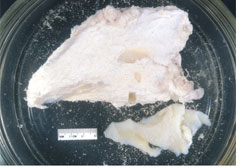Panama Creature

Panama Creature The "Panama Creature" (also variously referred to as the "Panama Monster", "Panama ET" "Cerro Azul Monster", "Blue Stream Monster" or "Blue Hill Horror") refers to a carcass photographed near the town of Cerro Azul, Panama, in September 2009. After the animal was discovered and reputedly killed by a group of teenagers, photographs of the corpse were given to Telemetro, a Panamanian television station. The story and pictures circulated, and comparisons to the Montauk Monster were made. There was speculation about the identity of the creature, with suggestions including a hairless sloth, an alien species and a creature new to science. A biopsy performed by the National Environmental Authority of Panama on the remains a few days after the creature's discovery concluded that the corpse was in fact that of a male brown-throated sloth. The odd appearance had been caused by underwater decomposition, which had resu...
















































